Andrew Tracy’s Memorial Service
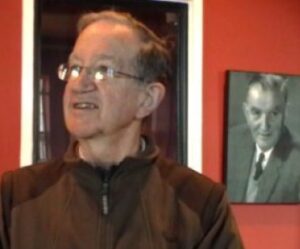
That is Andrew Tracey when I met him in 2008, with a photo of his father Hugh Tracey (circa 1960) looking over his shoulder. These two men are giants in the kalimba world. Their work is related to the preservation and understanding of the African kalimba family of instruments, and the creation of new kalimba designs.
Hugh Tracey spent decades traveling about southern Africa, recording, learning, and documenting the various traditional African instruments he encountered in the hinterlands. And of course, he made the world’s first kalimba business in 1954: African Musical Instruments (AMI).
However, it was largely through the work of his sons, Andrew and Paul Tracey, that the Hugh Tracey Kalimba would be popularized: they wrote “Wait a Minim”, a world music review that toured for seven years and played on Broadway over a year.
And while Hugh Tracey did a great deal of groundbreaking work on the kalimba and mbira, his son Andrew is the one who would unlock the secrets of the instruments’ tunings, which in turn illuminated the entire karimba family tree.
But when Hugh Tracey died suddenly in 1977, there was no plan. When he left for a tour of North America to speak about the kalimba, he told his eldest son, Andrew, to take care of business at ILAM, the International Library of African Music. He told Andrew’s wife, Heather Tracey, to watch after AMI, African Musical Instruments, the makers of the Hugh Tracey Kalimbas.
And so, husband and wife Andrew and Heather Tracey ran the two legacy institutions that Hugh Tracey left behind.
When they took over, one of the first things Andrew Tracey did was to get AMI to create and sell the African Tuned Karimba. Built on the body of the celeste kalimbas, using the hardward of the Treble Kalimba, Andrew took the tuning of the 15-Note Kwanongoma Karimba (aka the mbira nyunga nyunga), and added two more notes – a 4th in the upper octave, and a redundant root note on the far right side. He also tuned it up to A, while the Kwanongoma instrument was in F.
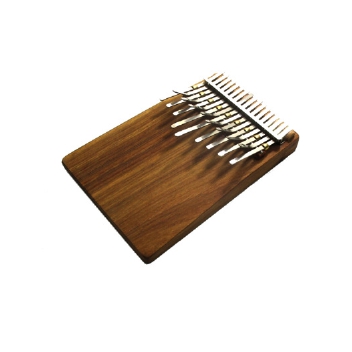 Why the Karimba?
Why the Karimba?When I appeared on the scene in 2005 with my business, Kalimba Magic, Andrew was just retiring from ILAM. When I came to visit AMI, ILAM, and Andrew Tracey, I was still just a kalimba player. The kalimba, in its modern form, is not a traditional African instrument. But the KARIMBA is a traditional African instrument, related on the evolutionary tree to the mbira dzazadzimu and all other southern African metal-tined lamellaphones.
In 1960, a wealthy white Rhodesian named Robert Sibson, decided to give back to Africa in a unique way. He realized that the diversity of African music was being trampled by western music, church music, and modern African pop music. Also, poor people from the hinterlands who played the traditional songs were moving to the cities and townships, and were being cut off from their musical traditions. Sibson decided he wanted to create a school to train people to play traditional African music. And so Kwanongoma College of African Music was born in Bullawayo Rhodesia (now Zimbabwe).
Sibson enlisted the now-famous Hugh Tracey to help him find teachers for the school, and Hugh enlisted his 24-year-old son Andrew Tracey to go out into the Bullawayo township and find musicians to teach at the school. Andrew told me that he did find a great many players, but many turned out to be unreliable or alcoholics, or reluctant to share their expertise with a young white man.
Andrew did strike gold though, when he found Jega Tapera. Jega played a 13-note version of the instrument that would become the Kwanongoma Karimba (aka the mbira nyunga nyunga) and the Hugh Tracey African-tuned Karimba. Jega was from Mozambique, and did not grow up in the Shona musical traditions of the area. But as a young man he had bought this karimba, and he collected songs from traveling musicians from many different ethnic groups. The fact that he could play the songs from many different peoples was amazing and important. You see, his instrument was sort of like the skeleton key that fit all the different mbiras. His instrument had the core notes of many different instruments. Andrew would come to call it the “original mbira” and the “kalimba core”. He asserted that all other metal-tined mbira evolved from this instrument. And the data supported this hypothesis.
By 1960, Andrew had been helping his father build the Hugh Tracey Kalimbas at African Musical Instruments (AMI). He could work with metal and make tines. When Jega Tapera found out that Andrew could make tines for him, he asked for two more tines. His 13-note karimba had slots for two more tines, which were missing. And so Andrew made those tines. bringing the instrument to the 15-Note Karimba that would be used at Kwanongoma.
Jega went on to teach Andrew all the songs that he knew. These songs became the basis of part of the curriculum at the Kwanongoma school. But these songs, and Jega’s karimba itself, would become the basis of a great deal of Andrew Tracey’s scholarly ethnomusicology research. Several of those songs are reproduced in numerical tablature that would appear in Paul F. Berliner’s book, “The Soul of Mbira”, and would be included in the 1-page insert shipped with the African-tuned Karimba from AMI. And those songs are also reproduced in the karimba books I have produced.
Here is Andrew Tracey, probably grinding metal tines for an mbira.
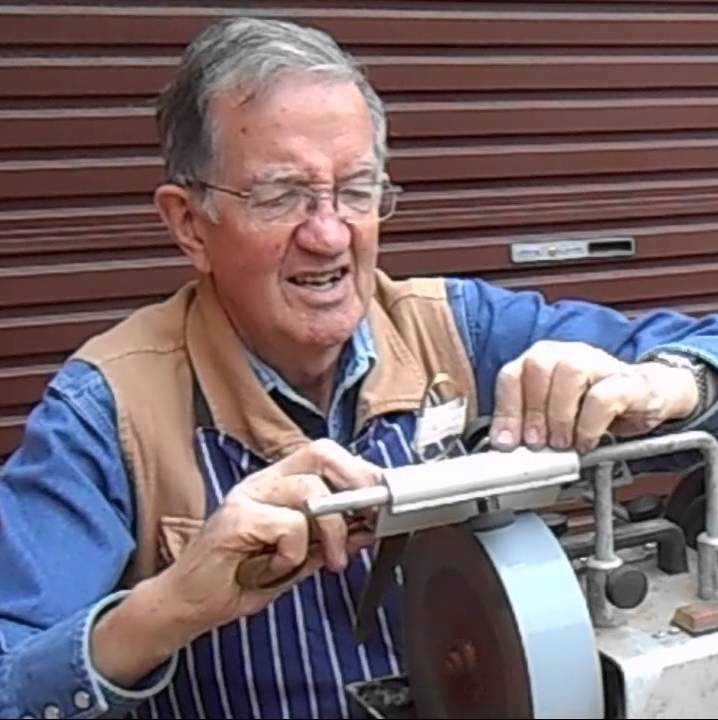
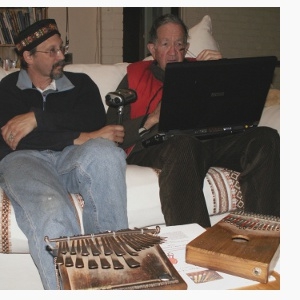
Here I am in 2008 (wearing a hat), interviewing Andrew, who sits behind my laptop. Christian Carver’s mbira and Alto Kalimba sit in the foreground. Sorry I don’t have the 2000 pixel version of this photo, the high resolution ones were lost in the flood. In this series of meetings over two weeks, I would come to understand a great deal about mbira music and the karimba. The basic premise is that the karimba is the older instrument, and the mbira dzavadzimu was derived from it (or at least, from the lower row of notes). This is based on the tines/notes that are common to the mbira dzavadzimu and the karimba.
But also, mbira dzavadzimu has complex stylized music that is based on a particular family of four phrase, 12 chord, chord progressions… which Andrew discerned in the 1960s. The karimba music from Jega Tapera mostly had simpler chord progressions – two phases, and typically 6 chords, in the chord progression. And the karimba chord progression fits within the mbira chord progression perfectly. OR another way to say it: the karimba could have come first, and then the mbira is invented centuries later, by adding more tines going outward and an extra low course of tines… and when more tines were added to make a more complex instrument, the ancestral Shona people also added to the older karimba chord progression.
To me, what this points to: when I play the traditional songs on the African Tuned Karimba, my thumbs are moving in some of the same patterns that the African ancients’ thumbs moved many centuries ago. Moving my thumbs thus, creating the same music and patterns made so long ago, my brain is in some way put into a state similar to the ancients’ brain states. The joy I experience? It might be the same joy that people in Africa experience centuries ago. This act of playing karimba music gives me great respect for the ancient African mind, that these people were able to figure out these instruments, these scales, and these songs. I cannot afford to go to Africa just now. And I will never be able to travel back in time 1000 years. But when I play karimba, I go there, to Africa, 1000 years ago. What an amazing opportunity, and I believe it is open to you too.
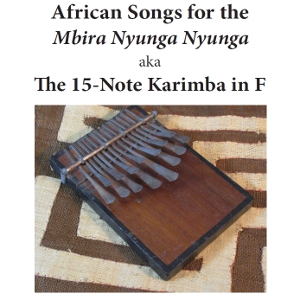 I know that a great many mbira purists look down on the Hugh Tracey Kalimbas and Karimbas as “European” or “white” instruments. To do so, however, ignores the central role that Hugh Tracey and Andrew Tracey played in understanding, preserving, and promoting traditional African musicians and their instruments. The friendships these men had with uncountable traditional African instruments were true and deep. Respect ran both ways.
I know that a great many mbira purists look down on the Hugh Tracey Kalimbas and Karimbas as “European” or “white” instruments. To do so, however, ignores the central role that Hugh Tracey and Andrew Tracey played in understanding, preserving, and promoting traditional African musicians and their instruments. The friendships these men had with uncountable traditional African instruments were true and deep. Respect ran both ways.
Yes, you can purchase a rustic handmade nyunga nyunga on ebay. I did, and there it is on the cover of my nyunga nyunga download, which includes the Andrew Tracey / Paul F. Berliner / Jega Tapera songs. The Hugh Tracey version? It is easier to maintain, in some ways easier to play, and right now it may very well be less expensive.
I invite you to celebrate Andrew Tracey’s life with one of the fruits of his scholarship, understanding, and mechanical efforts: the Hugh Tracey African Tuned Karimba. And because I still have quite a few of them left, I am offering them at 60% off.
The Story of the Karimba – and Why You Should Get One at 60% Savings


Sign up for our newsletter and free resources with your email address:
We pinky promise not to spam you and to only send good stuff.
 Christmas in July 2025
Christmas in July 2025 Patriotic and American Music for Kalimba
Patriotic and American Music for Kalimba